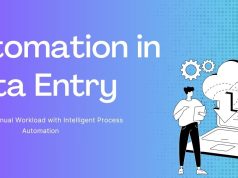In today’s data -driven commercial scenario, the way organizations can capture, treat and use it to create or break the competitive advantage. Computer registration – process for entering computer systems – is like a basic element of professional operations in industries.
The Evolution of Data Entry in Modern Business
This broad guide will detect the nuances of both manual and automated data registration method, which will help you decide which solution corresponds to the best requirements, budget shortages and long -term goals for your organization. Whether you are masters for a small company, who wants to optimize the operation or venture maker that evaluates data management strategies, it is necessary to understand these differences to make an alternative to your data processing processes.
Understanding Manual Data Entry: The Human Touch in Data Processing
Manual data registration involves providing physical information to human operators physically in the computer system. This traditional approach is the backbone of data processing for decades and continues to meet specific business requirements despite technological progress.
Key Characteristics of Manual Data Entry
- Human-driven process: Data is entered by staff members who interpret, categorize, and input information
- Direct oversight: Information passes through human verification during the entry process
- Flexible implementation: Can be performed with minimal technological infrastructure
- Adaptable to irregular or unstructured data: Humans can interpret context and make judgment calls
According to research by the Data Entry Association, approximately 31% of businesses still utilize primarily manual data entry methods for at least some critical processes. As noted by the experts at Data Entry Ninja, “The human element in data processing remains valuable for specific scenarios where context understanding and adaptability are paramount.”
Advantages of Manual Data Entry
- High adaptability to unusual data formats: Human operators can interpret and process non-standard information that might confuse automated systems
- Lower initial investment: Less upfront expense for technology infrastructure
- Easier implementation of quality control: Direct human oversight can catch contextual errors
- No programming or technical setup required: Can begin operations without specialized technical knowledge
- Flexibility with changing requirements: Humans can quickly adapt to new instructions or categories
Limitations of Manual Data Entry
- Time-intensive process: Significantly slower than automated alternatives
- Human error susceptibility: Studies from the Journal of Data Management show error rates averaging 1-3% in manual data entry
- Scalability challenges: Difficult to expand operations without proportional staff increases
- Higher long-term operational costs: Continuing labor expenses versus one-time system implementation
- Consistency concerns: Performance varies based on operator fatigue, training, and individual capabilities
The Rise of Automated Data Entry Solutions
Automatic data introduction benefits from technology to catch, interpret and enter data with minimal human intervention. These systems have evolved dramatically over the past decade, especially with artificial intelligence and progress in machine learning technologies.
Core Technologies Driving Automated Data Entry
- Optical Character Recognition (OCR): Converts printed or handwritten text into machine-readable format
- Intelligent Document Processing (IDP): Combines OCR with AI to understand document context and structure
- Natural Language Processing (NLP): Interprets and categorizes text-based information
- Robotic Process Automation (RPA): Creates software robots that mimic human actions for data tasks
- APIs and Integration Tools: Enables direct system-to-system data transfers
According to a 2024 report by Automation Anywhere, organizations implementing automated data entry solutions have seen an average productivity increase of 40-60% in their data processing workflows.
Benefits of Automated Data Entry
- Dramatic speed improvements: Processes that take hours manually can be completed in minutes
- Enhanced accuracy: Modern systems achieve 99%+ accuracy rates for structured data
- Scalability: Can handle increased volumes without proportional resource expansion
- Cost efficiency over time: Higher initial investment but lower long-term operational costs
- Consistency: Results don’t vary based on time of day or operator fatigue
- 24/7 operation capability: Systems can process data around the clock
- Integration capabilities: Seamlessly connects with existing business systems
Challenges of Automated Data Entry
- Higher initial investment: Significant upfront costs for software, training, and implementation
- Technical expertise requirements: Implementation and maintenance need specialized knowledge
- Difficulties with unstructured or unusual data: May struggle with non-standard formats
- Adaptation period: Staff must learn to work with and trust automated systems
- Potential for systematic errors: Without proper oversight, errors can propagate at scale
Comparative Analysis: Manual vs. Automated Data Entry
To make an informed decision about which approach best suits your business needs, consider these key comparison points:
Accuracy and Error Rates
Manual Data Entry:
- Average error rate: 1-3%
- Errors typically random and non-systematic
- Quality varies based on operator experience and fatigue
Automated Data Entry:
- Average error rate: 0.5-1% for structured data
- Higher error rates for unstructured information
- Errors tend to be systematic rather than random
- Maintains consistent quality regardless of volume
Processing Speed and Throughput
Manual Data Entry:
- Processing speed: ~10-15 records per minute (varies by complexity)
- Limited to working hours
- Throughput decreases with operator fatigue
Automated Data Entry:
- Processing speed: Hundreds to thousands of records per minute
- 24/7 operational capability
- Consistent processing speed regardless of volume
Implementation and Operational Costs
Manual Data Entry:
- Lower initial investment
- Higher ongoing operational costs
- Linear cost scaling with volume increases
Automated Data Entry:
- Higher upfront investment
- Lower ongoing operational costs
- Non-linear cost scaling (more efficient at larger volumes)
According to a 2024 cost analysis by McKinsey Digital, businesses processing over 1,000 documents monthly typically reach ROI on automated systems within 14-18 months.
Hybrid Approaches: The Best of Both Worlds
Many organizations are finding that a strategic hybrid approach—combining manual and automated data entry methods—offers the optimal solution for their specific needs.
Effective Hybrid Implementation Strategies
- Automation for routine, high-volume tasks: Use systems for predictable, standardized data
- Human oversight for exceptions and quality control: Leverage human judgment for unusual cases
- Progressive implementation: Start with automating simple processes before moving to complex ones
- Human-in-the-loop systems: Combine automation with human verification at critical points
As noted in a recent Harvard Business Review study, organizations implementing thoughtful hybrid approaches report 30% higher satisfaction with their data quality compared to those using exclusively manual or automated methods.
Making the Right Choice for Your Business
When deciding between manual and automated data entry approaches, consider these critical factors:
When Manual Data Entry May Be Preferable
- Small data volumes: Processing fewer than 100 records daily
- Highly variable or unstructured data: Information that requires significant interpretation
- Budget constraints: Limited capital for technology investment
- Temporary or short-term projects: Needs that don’t justify automation setup
- Specialized or unique data: Information requiring subject matter expertise
When Automated Data Entry Offers Clear Advantages
- Large data volumes: Processing hundreds or thousands of records daily
- Standardized data formats: Consistent structure across inputs
- Need for rapid processing: Time-sensitive information
- Integration requirements: Data flowing between multiple systems
- Long-term operational focus: Ongoing processes that justify initial investment
Implementation Considerations and Best Practices
Whether you choose manual, automated, or hybrid data entry approaches, follow these best practices for optimal results:
For Manual Data Entry Implementation
- Develop clear standard operating procedures: Create comprehensive guidelines for consistency
- Implement rigorous quality control: Build verification steps into your workflow
- Train staff thoroughly: Invest in ongoing skill development
- Use data validation tools: Implement basic technological aids to reduce errors
- Consider ergonomic workstations: Minimize fatigue and repetitive stress injuries
For Automated Data Entry Implementation
- Start with a comprehensive needs assessment: Clearly define your requirements
- Choose solutions that fit your specific use case: Avoid over-engineering
- Allocate resources for proper training: Ensure staff can effectively use the system
- Implement gradually: Phase automation in rather than switching all at once
- Establish monitoring protocols: Create systems to verify automation accuracy
Future Trends in Data Entry: What’s Next?
The landscape of data entry continues to evolve rapidly. Here are key trends to watch as you plan your data entry strategy:
- AI-powered contextual understanding: Systems that can interpret data more like humans
- Voice-based data entry: Increased use of speech recognition for data capture
- Mobile data collection: Field-based collection through smartphones and tablets
- Blockchain for data verification: Immutable records for critical information
- Ambient computing: Environmental sensors automatically capturing relevant data
Conclusion: Finding Your Data Entry Sweet Spot
The choice between manual and automated data registration is not binary – it is about finding the right approach to your specific business context. By understanding the strength and limitations of each method, you can develop a strategic approach that optimizes accuracy, efficiency and cost -effectiveness.
For most organizations, optimal solution is in combination with human expertise with technical abilities. As the data volumes continue to grow and the business environment is becoming increasingly complicated, the ability to strategically manage information input will remain an important competitive discrimination.
Whether you’re just beginning to explore data entry optimization or looking to refine existing processes, remember that the right approach is one that aligns with your specific business objectives, operational needs, and available resources. Consider consulting with data management specialists like Data Entry Ninja to develop a customized strategy that maximizes your data’s value while minimizing processing costs and errors.










